
- •Emissivity
- •Thermal imaging
- •Temperature sensor accessories
- •Process/instrument suitability
- •Review of fundamental principles
- •Venturi tubes and basic principles
- •Proper installation
- •Equation summary
- •Variable-area flowmeters
- •Rotameters
- •Velocity-based flowmeters
- •Positive displacement flowmeters
- •Weighfeeders
- •Change-of-quantity flow measurement
- •Process/instrument suitability
- •Review of fundamental principles
- •Continuous analytical measurement
- •Conductivity measurement
- •Dissociation and ionization in aqueous solutions
- •Electrodeless conductivity probes
- •pH measurement
- •Colorimetric pH measurement
- •Potentiometric pH measurement
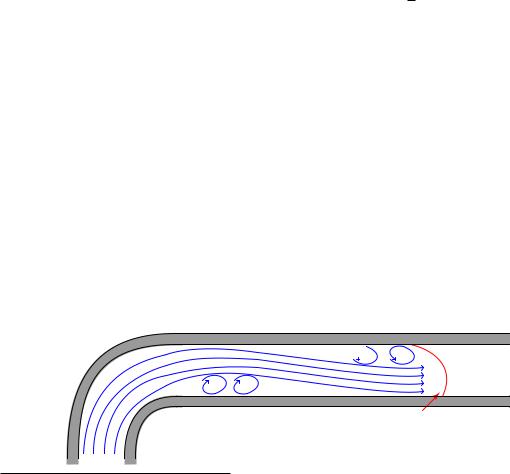
22.1. PRESSURE-BASED FLOWMETERS |
1637 |
22.1.7Proper installation
Perhaps the most common way in which the flow measurement accuracy of any flowmeter becomes compromised is incorrect installation, and pressure-based flowmeters are no exception to this rule. The following list shows some of the details one must consider in installing a pressure-based flowmeter element:
•Necessary upstream and downstream straight-pipe lengths
•Beta ratio (ratio of orifice bore diameter to pipe diameter: β = Dd )
•Impulse tube tap locations
•Tap finish
•Transmitter location in relation to the pipe
Sharp turns in piping networks introduce large-scale turbulence22 into the flowstream. Elbows, tees, valves, fans, and pumps are some of the most common causes of large-scale turbulence in piping systems. Successive pipe elbows in di erent planes are some of the worst o enders in this regard. When the natural flow path of a fluid is disturbed by such piping arrangements, the velocity profile of that fluid becomes distorted; e.g. the velocity gradient from one wall boundary of the pipe to the other will not be orderly. Large eddies in the flowstream (called swirl ) will appear. This may cause problems for pressure-based flow elements which rely on linear acceleration (change in velocity in one dimension) to measure fluid flow rate. If the flow profile is distorted enough, the acceleration detected at the element may be too great or too little, and therefore not properly represent the full fluid flowstream23. For this reason, pressure-based flowmeters should always be located upstream of major disturbances such as control valves and pipe elbows where possible.
Large-scale disturbances
pipe wall
swirl 
Fluid flow
swirl
pipe wall
Velocity profile
22This is not to be confused with micro-turbulence in the fluid, which cannot be eliminated at high Reynolds number values. In fact, “fully-developed turbulent flow” is desirable for head-based meter elements such as orifice plates because it means the flow profile will be relatively flat (even velocities across the pipe’s diameter) and frictional forces (viscosity) will be negligible. The thing we are trying to avoid is large-scale turbulent e ects such as eddies, swirl, and asymmetrical flow profiles, which compromise the ability of most flowmeters to accurate measure flow rate.
23L.K. Spink mentions in his book Principles and Practice of Flow Meter Engineering that certain tests have shown flow measurement errors induced from severe disturbances as far as 60 to 100 pipe diameters upstream of the primary flow element. The April 2000 update of API standard 14.3 (for custody-transfer measurement of natural gas using orifice plates) calls for upward of 145 pipe diameters of straight-length pipe upstream of the orifice plate!
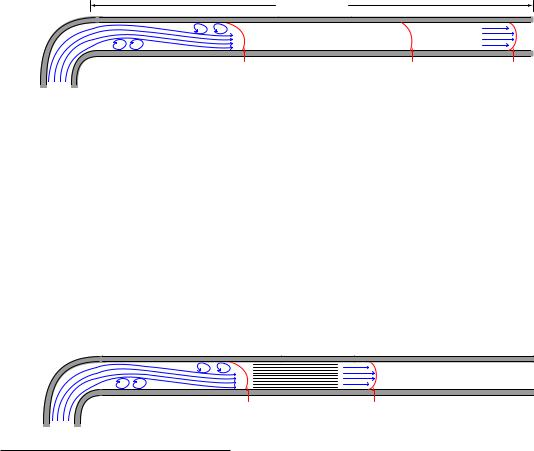
1638 |
CHAPTER 22. CONTINUOUS FLUID FLOW MEASUREMENT |
Even disturbances located downstream of the flow element may a ect measurement accuracy if the disturbances are severe enough and/or close enough to the flow element. Unfortunately, both upstream and downstream flow disturbances are unavoidable on all but the simplest fluid systems. This means we must devise ways to stabilize a flowstream’s velocity profile near the flow element in order to achieve accurate measurements of flow rate. A very simple and e ective way to stabilize a flow profile is to provide adequate lengths of straight pipe ahead of (and behind) the flow element. Given enough time, even the most chaotic flowstream will “settle down” to a symmetrical profile all on its own. The following illustration shows the e ect of a pipe elbow on a flowstream, and how the velocity profile returns to a normal (symmetrical) form after traveling through a su cient length of straight pipe:
Straight pipe length
pipe wall
Fluid flow
pipe wall
Velocity profile |
Velocity profile |
Velocity profile |
(asymmetrical) |
(still somewhat asymmetrical) |
(symmetrical) |
Recommendations for minimum upstream and downstream straight-pipe lengths vary significantly with the nature of the turbulent disturbance, piping geometry, and flow element. As a general rule, elements having a smaller beta ratio (ratio of throat diameter d to pipe diameter D) are more tolerant of disturbances, with profiled flow devices (e.g. venturi tubes, flow tubes, V-cones) having the greatest tolerance24. Ultimately, you should consult the flow element manufacturer’s documentation for a more detailed recommendation appropriate to any specific application.
In applications where su cient straight-run pipe lengths are impractical, another option exists for “taming” turbulence generated by piping disturbances. Devices called flow conditioners may be installed upstream of the flow element to help the flow profile achieve symmetry in a far shorter distance than simple straight pipe could do alone. Flow conditioners take the form of a series of tubes or vanes installed inside the pipe, parallel to the direction of flow. These tubes or vanes force the fluid molecules to travel in straighter paths, thus stabilizing the flowstream prior to entering a flow element:
|
Flow conditioner |
|
pipe wall |
|
pipe wall |
Velocity profile |
Velocity profile |
(asymmetrical) |
(symmetrical) |
24Flow elements with low beta ratio values tolerate greater disturbance in the flow pattern because they accelerate the flowstream to a greater degree. This may be best visualized by a thought experiment where we imagine an orifice plate with a very large beta ratio (i.e. one where the bore size is nearly as large as the pipe diameter): such an orifice plate would hardly accelerate the fluid at all, which would mean a mis-shapen flow profile entering the bore would probably remain mis-shapen exiting it. The acceleration imparted to a flowstream by a low-beta element tends to overshadow any asymmetries in the flow profile. However, there are disadvantages to using low-beta elements, one of them being increased permanent pressure loss which may translate to increased operating costs due to energy loss.
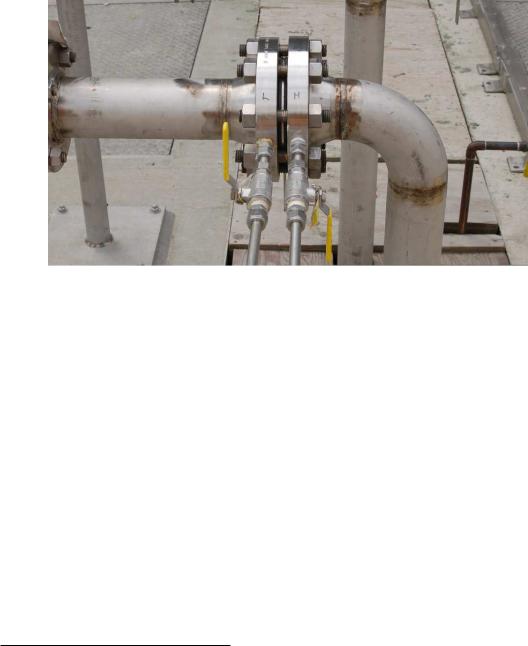
22.1. PRESSURE-BASED FLOWMETERS |
1639 |
This next photograph shows a very poor orifice plate installation, where the straight-run pipe requirements were completely ignored:
Not only is the orifice plate placed much too close to an elbow, the elbow happens to be on the upstream side of the orifice plate, where disturbances have the greatest e ect! The saving grace of this installation is that it is not used for critical monitoring or control: it is simply a manual indication of air flow rate where accuracy is not terribly important. Nevertheless, it is sad to see how an orifice meter installation could have been so easily improved with just a simple re-location of the orifice plate along the piping length.
Poor installations such as this are surprisingly common, owing to the ignorance many piping designers have of flowmeter design and operating principles. Of all the criteria which must be balanced when designing a piping layout, optimum flowmeter location is often placed low in the order of importance (if it appears at all!). In applications where accuracy is important, flowmeter location needs to be a very high priority even if it means a more expensive, cumbersome, and/or unattractive25 piping design.
25Beauty is truly in the eye of the beholder. While a piping designer might see straight-run lengths of pipe in awkward locations – necessitating more pipe and/or more bends elsewhere in the system to accommodate – as wasteful and ugly, the instrument engineer sees it as a thing of beauty.
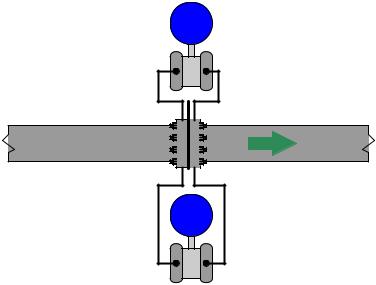
1640 |
CHAPTER 22. CONTINUOUS FLUID FLOW MEASUREMENT |
Another common source of trouble for pressure-based flowmeters is improper transmitter location. Here, the type of process fluid flow being measured dictates how the pressure-sensing instrument should be located in relation to the pipe. For gas and vapor flows, it is important that no stray liquid droplets collect in the impulse lines leading to the transmitter, lest a vertical liquid column begin to collect in those lines and generate an error-producing pressure. For liquid flows, it is important that no gas bubbles collect in the impulse lines, or else those bubbles may displace liquid from the lines and thereby cause unequal vertical liquid columns, which would (again) generate an error-producing di erential pressure.
In order to let gravity do the work of preventing these problems, we must locate the transmitter above the pipe for gas flow applications and below the pipe for liquid flow applications. This illustration shows both installations for a horizontal pipe:
Proper mounting position for measuring
gas flow
H L
Pipe |
Flow |
Proper mounting position for measuring
liquid flow
H L
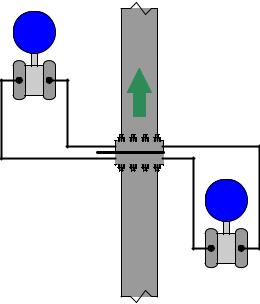
22.1. PRESSURE-BASED FLOWMETERS |
1641 |
This next illustration shows both installations on a vertical pipe:
Proper mounting position for measuring
gas flow
H L
Flow |
Pipe
Proper mounting position for measuring
liquid flow
H L
Condensible vapor applications (such as steam flow measurement) have traditionally been treated similarly to liquid measurement applications. Here, condensed liquid will collect in the transmitter’s impulse lines so long as the impulse lines are cooler than the vapor flowing through the pipe (which is typically the case). Placing the transmitter below the pipe allows vapors to condense and fill the impulse lines with liquid (condensate), which then acts as a natural seal protecting the transmitter from exposure to hot process vapors.
In such applications it is important for the technician to pre-fill both impulse lines with condensed liquid prior to placing the flowmeter into service. “Tee” fittings with removable plugs or fill valves are provided to do this. Failure to pre-fill the impulse lines will likely result in measurement errors during initial operation, as condensed vapors will inevitably fill the impulse lines at slightly di erent rates and cause a di erence in vertical liquid column heights within those lines.
It should be noted that some steam flow element installations, however, will work well if the impulse lines are above the pipe. If such an installation is possible, the advantage of not having to deal with pre-filling impulse lines (or waiting for steam to condense to equal levels in both lines) are significant. For more information, I recommend consulting the Rosemount whitepaper entitled “Top Mount Installation for DP Flowmeters in Steam Service” (document 00870-0200-4809 first published August 2009).
If tap holes must be drilled into the pipe (or flanges) at the process site, great care must be taken to properly drill and de-burr the holes. A pressure-sensing tap hole should be flush with the inner pipe wall, with no rough edges or burrs to create turbulence. Also, there should be no reliefs or countersinking near the hole on the inside of the pipe. Even small irregularities at the tap holes may generate surprisingly large flow-measurement errors.

1642 |
CHAPTER 22. CONTINUOUS FLUID FLOW MEASUREMENT |
22.1.8High-accuracy flow measurement
When we derived a formula for predicting flow rate from pressure dropped by a venturi tube (or orifice), we had to make many assumptions, chief among them being a total lack of friction (i.e. no energy dissipated due to friction) within the moving fluid and perfect stream-line flow (i.e. complete lack of turbulence). Su ce it to say, the flow formulae you have seen so far in this chapter are only approximations of reality. Orifice plates are some of the worst o enders in this regard, since the fluid encounters such abrupt changes in geometry passing through the orifice. Venturi tubes are nearly ideal, since the machined contours of the tube ensure gradual changes in fluid pressure and minimize turbulence.
However, in the real world we must often do the best we can with imperfect technologies. Orifice plates, despite being less than perfect as flow-sensing elements, are convenient and economical to install in flanged pipes. Orifice plates are also the easiest type of flow element to replace in the event of damage or routine servicing. In applications such as custody transfer (also called “fiscal” measurement), where the flow of fluid represents product being bought and sold, flow measurement accuracy is paramount. It is therefore important to figure out how to coax the most accuracy from the common orifice plate in order that we may measure fluid flows both accurately and economically.
If we compare the true flow rate through a pressure-generating primary sensing element against the theoretical flow rate predicted by an idealized equation, we may notice a substantial discrepancy26. Causes of this discrepancy include, but are not limited to:
•Energy losses due to turbulence and viscosity
•Energy losses due to friction against the pipe and element surfaces
•Unstable location of vena contracta with changes in flow
•Uneven velocity profiles caused by irregularities in the pipe
•Fluid compressibility
•Thermal expansion (or contraction) of the element and piping
•Non-ideal pressure tap location(s)
•Excessive turbulence caused by rough internal pipe surfaces
The ratio between true flow rate and theoretical flow rate for any measured amount of di erential pressure is known as the discharge coe cient of the flow-sensing element, symbolized by the variable C. Since a value of 1 represents a theoretical ideal, the actual value of C for any real pressuregenerating flow element will be less than 1:
True flow
C = Theoretical flow
26Richard W. Miller, in his outstanding book Flow Measurement Engineering Handbook, states that venturi tubes may come within 1 to 3 percent of ideal, while a square-edged orifice plate may perform as poorly as only 60 percent of theoretical!

22.1. PRESSURE-BASED FLOWMETERS |
1643 |
For gas and vapor flows, true flow rate deviates even more from the theoretical (ideal) flow value than liquids do, for reasons that have to do with the compressible nature of gases and vapors. A gas expansion factor (Y ) may be calculated for any flow element by comparing its discharge coe cient for gases against its discharge coe cient for liquids. As with the discharge coe cient, values of Y for any real pressure-generating element will be less than 1:
|
|
|
Y = |
Cgas |
|
|
|
|
|
|
Cliquid |
|
|
||
|
|
|
|
|
|
||
|
|
True gas flow |
|
||||
Y = |
Theoretical gas flow |
||||||
True liquid flow |
|||||||
|
|
|
|
||||
|
Theoretical liquid flow |
||||||
Incorporating these factors into the ideal volumetric flow equation developed on in section 22.1.1, we arrive at the following formulation:
Q = √ |
|
|
|
A2 |
|
2 s |
|
ρ |
||
|
|
|
CY A2 |
|
|
|
|
P1 − P2 |
|
|
2 |
|
|
|
|
|
|
||||
r |
|
|
|
|
|
|||||
|
|
1 − A1 |
|
|
|
|
|
|
||
If we wished, we could even add another factor to account for any necessary unit conversions |
||||||||||||
|
√ |
|
in the process: |
|
|
|
|
|
|
|
||
(N ), getting rid of the constant |
2 |
|
|
|
|
|
|
|
||||
|
|
|
|
|
A2 |
|
2 s |
|
|
|
|
|
|
|
|
|
|
|
|
ρ |
|||||
|
Q = N |
|
CY A2 |
|
|
|
|
P1 − P2 |
|
|||
|
|
|
|
|
|
|
||||||
|
r1 − A1 |
|
|
|
||||||||
|
|
|
|
|
|
|
|
|
|
|||
Sadly, neither the discharge coe cient (C) nor the gas expansion factor (Y ) will remain constant across the entire measurement range of any given flow element. These variables are subject to some change with flow rate, which further complicates the task of accurately inferring flow rate from di erential pressure measurement. However, if we know the values of C and Y for typical flow conditions, we may achieve good accuracy most of the time.
Likewise, the fact that C and Y change with flow places limits on the accuracy obtainable with the “proportionality constant” formulae seen earlier. Whether we are measuring volumetric or mass flow rate, the k factor calculated at one particular flow condition will not hold constant for all flow conditions:
s |
ρ |
|
Q = k |
P1 − P2 |
|
|
||
p
W = k ρ(P1 − P2)
This means after we have calculated a value for k based on a particular flow condition, we can only trust the results of the equation for flow conditions not too di erent from the one we used to calculate k.

1644 |
CHAPTER 22. CONTINUOUS FLUID FLOW MEASUREMENT |
As you can see in both flow equations, the density of the fluid (ρ) is an important factor. If fluid density is relatively stable, we may treat ρ as a constant, incorporating its value into the proportionality factor (k) to make the two formulae even simpler:
p
Q = kQ P1 − P2
p
W = kW P1 − P2
However, if fluid density is subject to change over time, we will need some means to continually calculate ρ so our inferred flow measurement will remain accurate. Variable fluid density is a typical state of a airs in gas flow measurement, since all gases are compressible by definition. A simple change in static gas pressure within the pipe is all that is needed to make ρ change, which in turn a ects the relationship between flow rate and di erential pressure drop.
The American Gas Association (AGA) provides a formula for calculating volumetric flow of any gas using orifice plates in their #3 Report, compensating for changes in gas pressure and temperature. A variation of that formula is shown here (consistent with previous formulae in this section):
|
|
A2 |
|
2 s |
|
Gf Zf 1T |
||
Q = N |
|
CY A2 |
|
|
|
|
ZsP1(P1 − P2) |
|
r |
|
|
|
|
|
|||
|
1 − A1 |
|
|
|
|
|
|
|
Where,
Q = Volumetric flow rate (SCFM = standard cubic feet per minute) N = Unit conversion factor
C = Discharge coe cient (accounts for energy losses, Reynolds number corrections, pressure tap locations, etc.)
Y = Gas expansion factor
A1 = Cross-sectional area of mouth A2 = Cross-sectional area of throat
Zs = Compressibility factor of gas under standard conditions
Zf 1 = Compressibility factor of gas under flowing conditions, upstream Gf = Specific gravity of gas (density compared to ambient air)
T = Absolute temperature of gas P1 = Upstream pressure (absolute)
P2 = Downstream pressure (absolute)
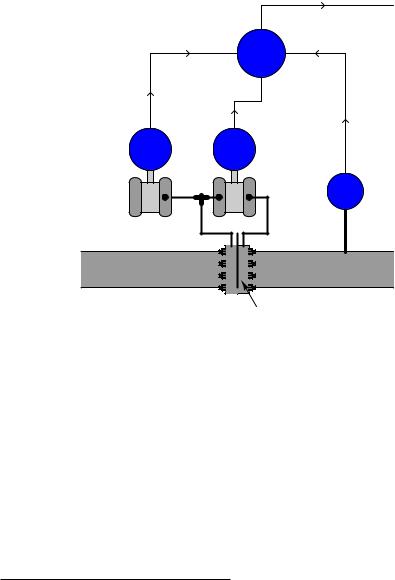
22.1. PRESSURE-BASED FLOWMETERS |
1645 |
This equation implies the continuous measurement of absolute gas pressure (P1) and absolute gas temperature (T ) inside the pipe, in addition to the di erential pressure produced by the orifice plate (P1 − P2). These measurements may be taken by three separate devices, their signals routed to a gas flow computer:
|
Flow signal to |
|
|
flow indicator, |
|
Computer |
flow controller, |
|
etc. |
||
|
||
|
FY |
Absolute pressure |
Differential pressure |
transmitter |
transmitter |
PT PDT
Absolute temperature transmitter
L |
H |
H |
L |
Gas flow 
TT
RTD
Orifice plate
Note the location of the RTD (thermowell), positioned downstream of the orifice plate so the turbulence it generates will not create additional turbulence at the orifice plate. The American Gas Association (AGA) allows for upstream placement of the thermowell, but only if located at least three feet upstream of a flow conditioner27.
In order to best control all the physical parameters necessary for good orifice metering accuracy, it is standard practice for custody transfer flowmeter installations to use honed meter runs rather than standard pipe and pipe fittings. A “honed run” is a complete piping assembly consisting of a manufactured fitting to hold the orifice plate and su cient straight lengths of pipe upstream and downstream, the interior surfaces of that pipe machined (“honed”) to have a glass-smooth surface with precise and symmetrical dimensions. Honed runs ensure minimum disruption to the flowing gas or liquid, thus improving measurement accuracy by avoiding unnecessary turbulence and/or distorted flow profiles. Such piping “runs” are quite expensive, but necessary to achieve flow measurement accuracy worthy of custody transfer.
27Specified in Part 2 of the AGA Report #3, section 2.6.5, page 22. A major reason for this is von K´arm´an vortex shedding caused by the gas having to flow around the width of the thermowell. The “street” of vortices shed by the thermowell will cause serious pressure fluctuations at the orifice plate unless mitigated by a flow conditioner, or by locating the thermowell downstream so that the vortices do not reach the orifice.
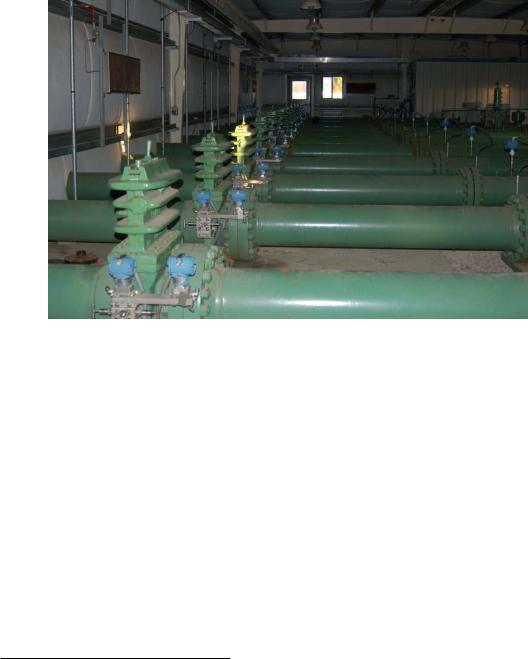
1646 |
CHAPTER 22. CONTINUOUS FLUID FLOW MEASUREMENT |
This photograph shows a set of AGA3-compliant orifice meter runs measuring the flow of natural gas:
Note the special transmitter manifolds, built to accept both the di erential pressure and absolute pressure (Rosemount model 3051) transmitters. Also note the quick-change fittings (the ribbed metal housings) holding the orifice plates, to facilitate convenient change-out of the orifice plates which is periodically necessary due to wear. It is not unheard of to replace orifice plates on a daily basis in some industries to ensure the sharp orifice edges necessary for accurate measurement28.
Although not visible in this photograph, these meter runs are connected together by a network of shut-o valves directing the flow of natural gas through as few meter runs as desired. When the total gas flow rate is great, all meter runs are placed into service and their respective flow rates summed to yield a total flow measurement. When the total flow rate decreases, individual meter runs are shut o , resulting in increased flow rates through the remaining meter runs. This “staging” of meter runs expands the e ective turndown or rangeability of the orifice plate as a flow-sensing element, resulting in much more accurate flow measurement over a wide range of flow rates than if a single (large) orifice meter run were used.
28This is especially true in the gas exploration industry, where natural gas coming out of the well is laden with mineral debris.
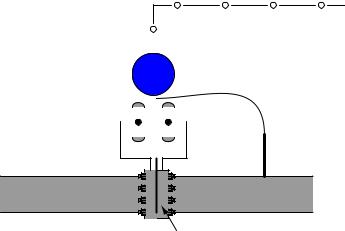
22.1. PRESSURE-BASED FLOWMETERS |
1647 |
An alternative to multiple instruments (di erential pressure, absolute pressure, and temperature) installed on each meter run is to use a single multi-variable transmitter capable of measuring gas temperature as well as both static and di erential pressures. This approach enjoys the advantage of simpler installation over the multi-instrument approach:
Digital bus
Multivariable transmitter |
|
|
|
|
|
|
|
|
|
|
|
|
|
|
|
||
(measures static pressure, |
|
|
UT |
|
||||
differential pressure, and |
|
|
|
|
|
|
|
|
temperature in one unit) |
|
|
|
|
|
|
|
|
H |
|
|
L |
|
||||
|
|
|
|
|
|
|
|
|
|
|
|
|
|
|
|
|
|
RTD
Gas flow 
Orifice plate
The Rosemount model 3095MV and Yokogawa model EJX910 are examples of multi-variable transmitters designed to perform compensated gas flow measurement, equipped with multiple pressure sensors, a connection port for an RTD temperature sensor, and su cient digital computing power to continuously calculate flow rate based on the AGA equation. Such multi-variable transmitters may provide an analog output for computed flow rate, or a digital output where all three primary variables and the computed flow rate may be transmitted to a host system (as shown in the previous illustration). The Yokogawa EJX910A provides an interesting signal output option: a digital pulse signal, where each pulse represents a specific quantity (either volume or mass) of fluid. The frequency of this pulse train represents flow rate, while the total number of pulses counted over a period of time represents the total amount of fluid that has passed through the orifice plate over that amount of time.
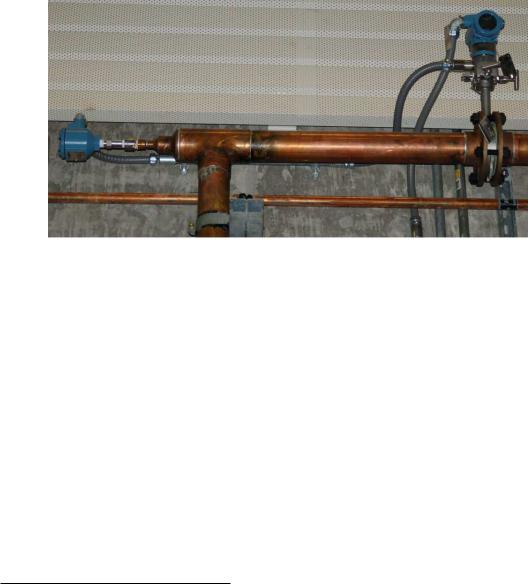
1648 |
CHAPTER 22. CONTINUOUS FLUID FLOW MEASUREMENT |
This photograph shows a Rosemount 3095MV transmitter used to measure mass flow on a pure oxygen (gas) line. The orifice plate is an “integral” unit immediately below the transmitter body, sandwiched between two flange plates on the copper line. A three-valve manifold interfaces the model 3095MV transmitter to the integral orifice plate structure:
The temperature-compensation RTD may be clearly seen on the left-hand side of the photograph, installed at the elbow fitting in the copper pipe.
Liquid flow measurement applications may also benefit from compensation, because liquid density changes with temperature. Static pressure is not a concern here, because liquids are considered incompressible for all practical purposes29. Thus, the formula for compensated liquid flow measurement does not include any terms for static pressure, just di erential pressure and temperature:
|
|
CY A2 |
|
|
|
|
|
Q = N |
|
|
|
q(P1 − P2)[1 + kT (T − Tref )] |
|||
|
|
|
|
|
|||
r1 − |
A2 |
|
2 |
||||
|
A1 |
|
|
|
|||
The constant kT shown in the above equation is the proportionality factor for liquid expansion with increasing temperature. The di erence in temperature between the measured condition (T ) and the reference condition (Tref ) multiplied by this factor determines how much less dense the liquid is compared to its density at the reference temperature. It should be noted that some liquids
– notably hydrocarbons – have thermal expansion factors significantly greater than water. This makes temperature compensation for hydrocarbon liquid flow measurement very important if the measurement principle is volumetric rather than mass-based.
29Liquids can and do compress, the measurement of their “compressibility” being what is called the bulk modulus. However, this compressibility is too slight to be of any consequence in most flow measurement applications. A notable exception is the metering of diesel fuel through a high-pressure injection pump, where liquid pressures range in the tens of thousands of PSI, and the compressibility of the liquid diesel fuel may a ect the precise timing of individual injections into the engine cylinders.
